Welcome to your guide to the beginners garden! In this article, I will share valuable tips and tricks that will help you successfully start your own garden, even if you have no prior gardening experience. From choosing the right plants for your growing conditions to proper planting and care techniques, this guide will provide you with all the information you need to create a beginner-friendly garden.
Key Takeaways:
- Choose plants that match your growing conditions
- Start small and expand gradually
- Prepare the soil properly
- Plan your garden for proper placement of plants
- Feed and water plants regularly
- Be kind to wildlife and create habitats for them in your garden
Whether you have a large yard or a small balcony, you can create a beautiful and productive garden with the right guidance. Let’s get started!
Choosing the Right Plants for Your Growing Conditions
One of the key factors to consider when starting a garden is choosing the right plants that will thrive in your specific growing conditions. It’s important to select plants that match the conditions of your garden, such as putting sun-loving plants in sunny spots and choosing heat-tolerant plants in warm climates.
Knowing your hardiness zone can help you choose plants that will thrive in your area. The USDA hardiness map divides the United States into 13 zones based on minimum winter temperatures. When selecting plants, it’s important to choose ones that are recommended for your hardiness zone to ensure they will survive the winter. You can find your hardiness zone by visiting the USDA’s website and entering your zip code.
Understanding your frost dates is also crucial to avoid planting too early or late in the season. Frost dates refer to the average dates of the first and last frost in your area. Knowing your frost dates can help you determine the best time to plant different types of vegetables and flowers. You can find your frost dates by visiting various online tools or contacting your local extension office for more information.
Proper soil preparation is necessary for healthy plants, so it is recommended to add organic compost and other ingredients to improve the soil quality. Proper spacing of plants is important to avoid overcrowding and ensure proper growth. Knowing the water requirements of different plants is key, as different plants require different amounts of water. Regular watering and feeding of plants are essential for their well-being and growth.
Proper mulching helps maintain soil moisture and regulate soil temperature, but it’s important not to use too much or too little mulch. Beginners should start small instead of taking on too much at once. Keeping an eye on pests and taking action when necessary is crucial for protecting your plants. Composting kitchen and garden waste is beneficial for the environment and can be used as mulch. Learning how to properly prune plants is important for their overall health and appearance. Finally, creating habitats for wildlife and enjoying your garden space are important aspects of gardening.
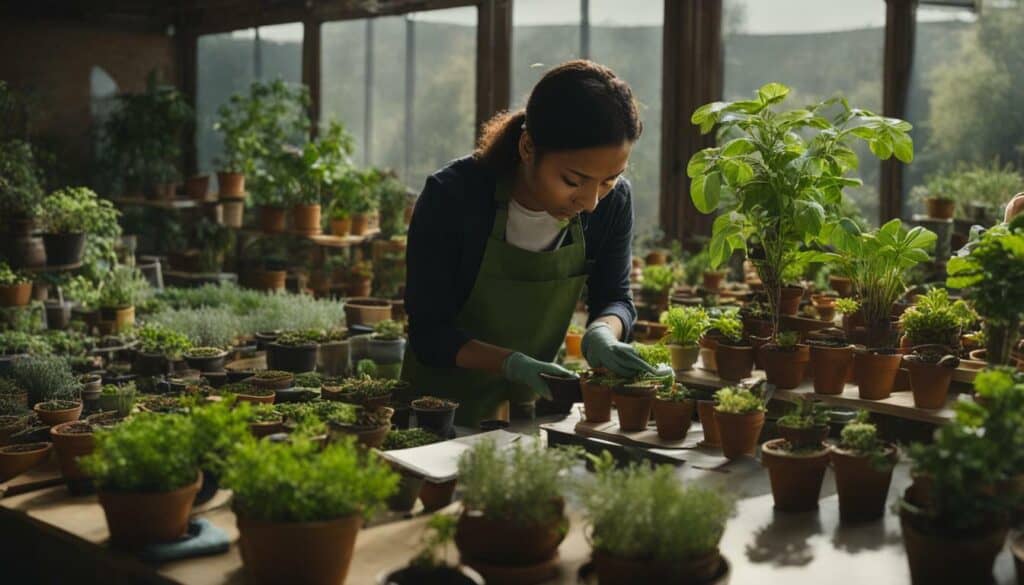
Choosing the right plants for your garden is essential for success. Making sure they are suitable for your growing conditions, properly spaced, and well-suited to your climate and sunlight requirements will ensure healthy, thriving plants.
Discovering Your Hardiness Zone and Frost Dates
Understanding your hardiness zone and being aware of your frost dates are crucial in successfully planning and maintaining your garden. Your hardiness zone determines which plants are most likely to thrive in your climate, while frost dates help you to avoid planting too early or too late, which can damage your crops.
To determine your hardiness zone, you need to find out the coldest place where plants can grow in your area. This will tell you which plants can survive in your climate. The United States Department of Agriculture (USDA) hardiness zone map is a useful tool to find out your hardiness zone.
| Hardiness Zone | Climate Conditions |
|---|---|
| Zones 1-3 | Cold and harsh climates with long winters |
| Zones 4-6 | Moderate climates with cold winters and warm summers |
| Zones 7-10 | Mild to warm climates with short winters and long summers |
Once you know your hardiness zone, it’s important to research the last average spring frost date and the first average fall frost date for your area. This will help you determine the best time to plant and harvest your crops. Planting too early or too late can cause damage to your plants, resulting in a poor crop yield.
It’s also important to select plants that are compatible with your growing zone to ensure successful growth. Some plants are more tolerant of cold weather, while others can withstand the heat. Choosing plants that are suitable for your climate is essential to prevent damage and maximize growth.
Frost protection is also important in colder climates. Consider using protective coverings such as plastic or fabric to keep your plants warm during frosty periods.
Understanding your hardiness zone and frost dates is just the beginning of successful gardening. Proper planning, getting to know your garden, learning how to plant, and providing appropriate care such as watering and feeding regularly are essential tips for beginner gardeners. Composting, pruning plants, and creating a welcoming environment for wildlife are other aspects of gardening that can enhance your enjoyment of your garden space.
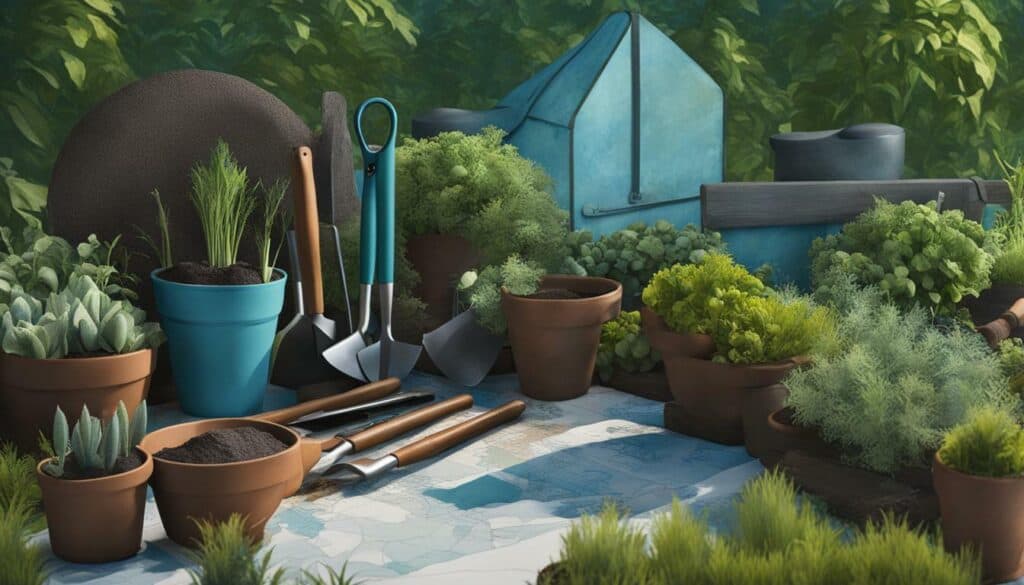
“To plant a garden is to believe in tomorrow.” – Audrey Hepburn
Starting Small and Getting to Know Your Garden
When you’re just starting out, it’s advisable to begin with a small garden area and gradually expand as you become more comfortable with gardening. This approach allows you to get to know your garden space and understand its unique characteristics. By starting small, you can focus your attention on a specific area and learn about its aspects, such as the amount of sunlight it receives and any potential challenges it may present.
One of the first steps to successful gardening is choosing the right plants for your garden space. If you have a small garden, you need to carefully consider the plants you select to ensure they fit in your space. Opting for plants that are manageable in size and easy to care for will help ensure your success.
Gardening beginners should also consider their garden layout and design carefully. Get to know your garden space’s dimensions, shape, and soil type. Test the soil pH level to determine what plants will grow well. Planning is essential to ensure you make the most of your garden space and not overcrowd plants. You may want to consider using raised beds or pots to make best use of your garden space.
Starting small also gives you time to learn how to properly plant your plants. It’s important to space them correctly and plant them at the right depth to ensure their growth and longevity. For instance, planting too shallow can cause them to dry out, and planting too deep can suffocate their roots.
Regular feeding and watering of your plants is necessary to maintain their health. Keep an eye on pests and diseases, and apply organic pest control methods when necessary. Don’t be afraid to prune your plants as it can promote healthier growth and help control their shape.
Lastly, creating a garden that welcomes wildlife is essential to enhancing biodiversity and enjoying your garden space. By planting nectar-rich flowers and creating habitats for wildlife, you can attract bees, butterflies, and other beneficial insects, creating a natural balance in your garden.
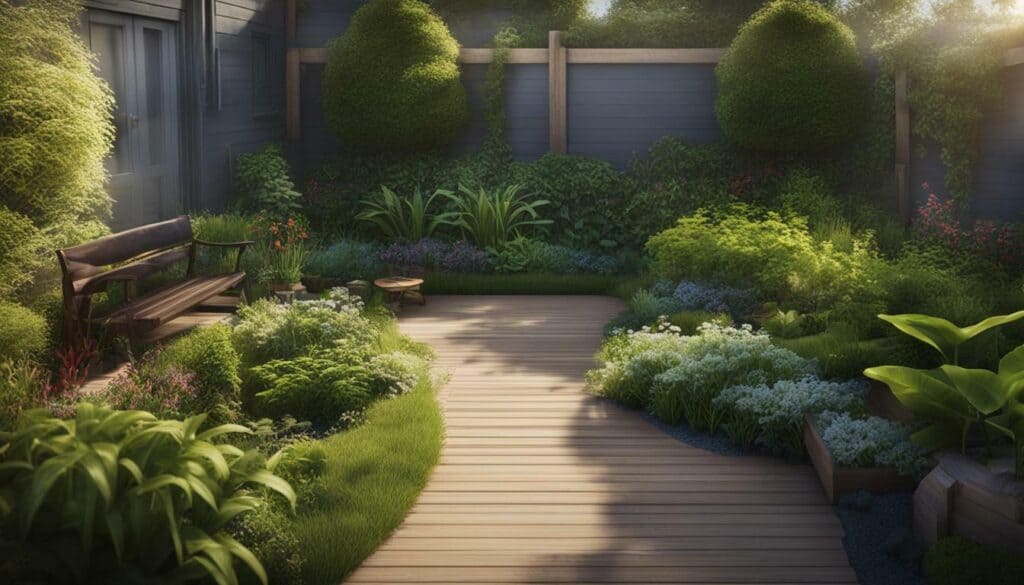
Start small and work your way up. Gardening can be an intimidating endeavor, but by beginning with a small garden area and gradually expanding as you gain experience, you can build the skills and confidence needed to create a thriving garden.
Planning Your Garden Space
Proper planning of your garden space is essential for creating an organized and visually pleasing garden. When selecting plants, it’s important to consider your growing conditions. For instance, sun-loving plants require a spot with ample sunlight, while sprawling vines need room to grow. Determining your hardiness zone and frost dates is also key in selecting plants that will thrive in your area.
Preparing the soil is another crucial factor. Adding organic compost and testing the soil’s pH level can help ensure optimal growth. Proper spacing of plants is important for providing room for each plant to flourish. Regular watering and feeding are also necessary for maintaining healthy plants.
Keeping an eye out for pests is important for maintaining the health of your garden. Utilizing compost can also help enrich the soil and promote healthy growth.
Pruning is also important for maintaining the overall health and appearance of your garden. Creating habitats for wildlife can also contribute to a thriving and balanced ecosystem.
Don’t forget to design a space where you can relax and enjoy the beauty of your garden. With proper planning and care, your garden will be an enjoyable and fruitful experience.
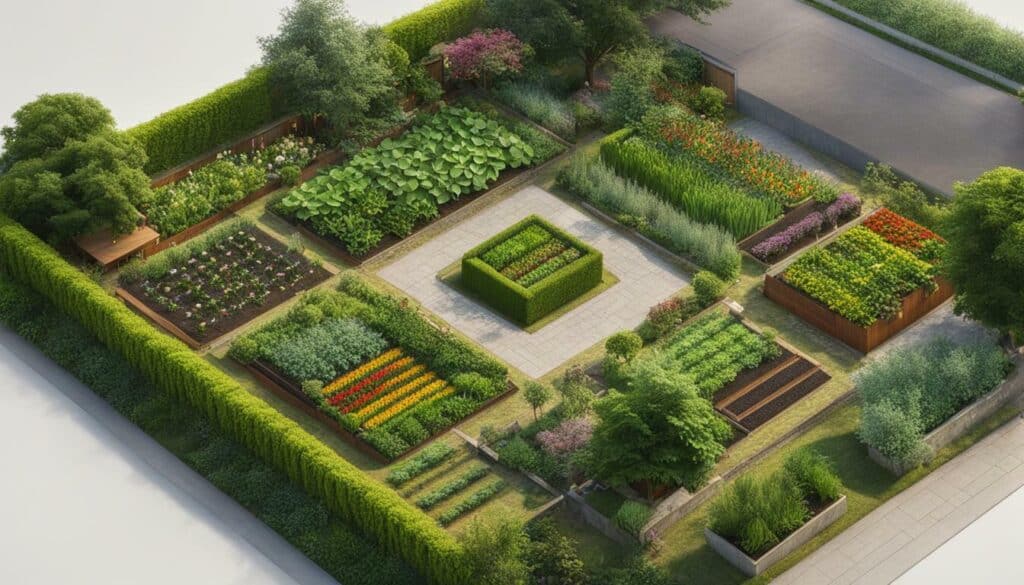
Proper Planting and Care Techniques
To ensure the success of your garden, it’s crucial to learn and implement proper planting and care techniques for your plants. This starts with selecting plants that are suitable for your growing conditions and knowing your hardiness zone and frost dates to make informed planting decisions.
When planting, choose an area with sufficient sunlight and access to water. Start small and focus on one area at a time, as proper spacing of plants is crucial to prevent overcrowding, which can lead to poor growth and minimal production.
Preparing the soil properly is essential for healthy plant growth. Add organic compost and other soil amendments to provide essential nutrients. Mulching is another important aspect of gardening as it helps regulate soil temperature, maintain soil moisture, and suppress weed growth. However, it’s important to use the right amount of mulch to avoid issues such as root rot or inadequate insulation for the plants.
Feeding and watering plants regularly, especially during the growing season, is crucial to their survival. Knowing when and how to feed and water plants is essential to their growth and flowering potential. Weeding is important to remove unwanted plants that can compete for nutrients.
Keeping an eye on pests is also important to prevent infestations that can harm your plants. Utilize organic pest control methods to avoid harming beneficial insects and pollinators. Pruning plants is necessary for their overall health and appearance. Learning when and how to prune plants is important for their growth and flowering potential.
Finally, creating a garden that is friendly to wildlife is beneficial for the overall ecosystem. Plant native species and provide habitat for birds, bees, and other beneficial insects. Enjoying your garden and creating a space for relaxation and appreciation of nature is also important.
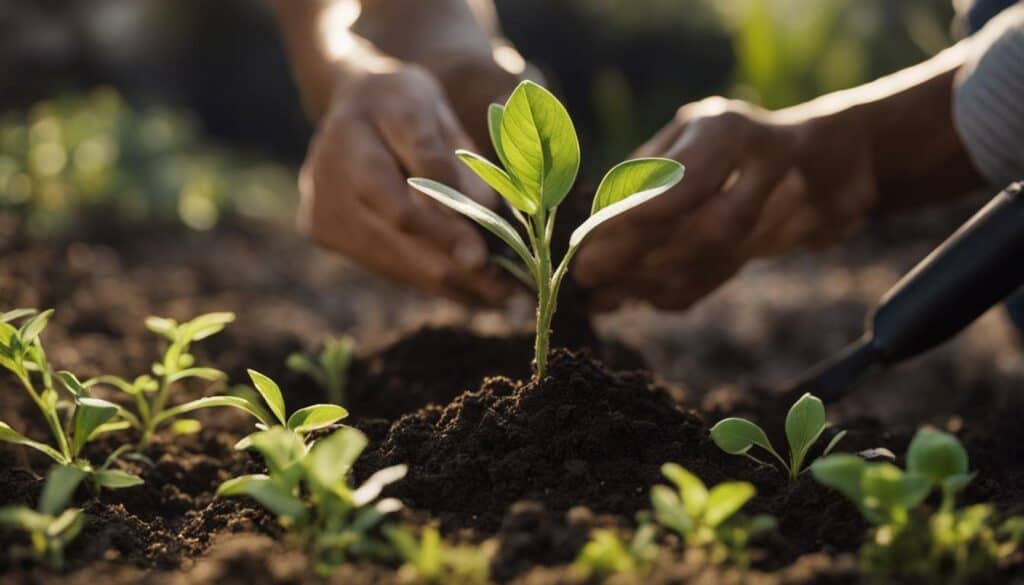
“Good-quality compost is the single most important additive for ensuring healthy plants.” -Organic Gardening Magazine
Watering, Feeding, and Pest Control
Watering, feeding, and pest control are important aspects of gardening that require attention to ensure the well-being of your plants. One key strategy for effective watering is to consider the individual needs of each plant, as different species may require different amounts of water or frequency of watering. It’s also important to water at the right time, such as early in the morning or in the evening, to help prevent water evaporation and ensure proper absorption.
Regular feeding during the growing season is essential to support healthy plant growth and development. This can be achieved through the use of organic or synthetic fertilizers, applied according to instructions and based on the specific needs of the plants. Additionally, regular pruning and thinning can help promote stronger and healthier growth, as well as reducing the risk of diseases and pests.
Garden pests and diseases can be a major threat to the health of your plants and the success of your garden. Organic pest control methods, such as companion planting, natural predators, and organic insecticides, can be effective in preventing infestations while reducing harm to the environment. It’s important to monitor your garden regularly for signs of pests or diseases and take necessary action promptly.
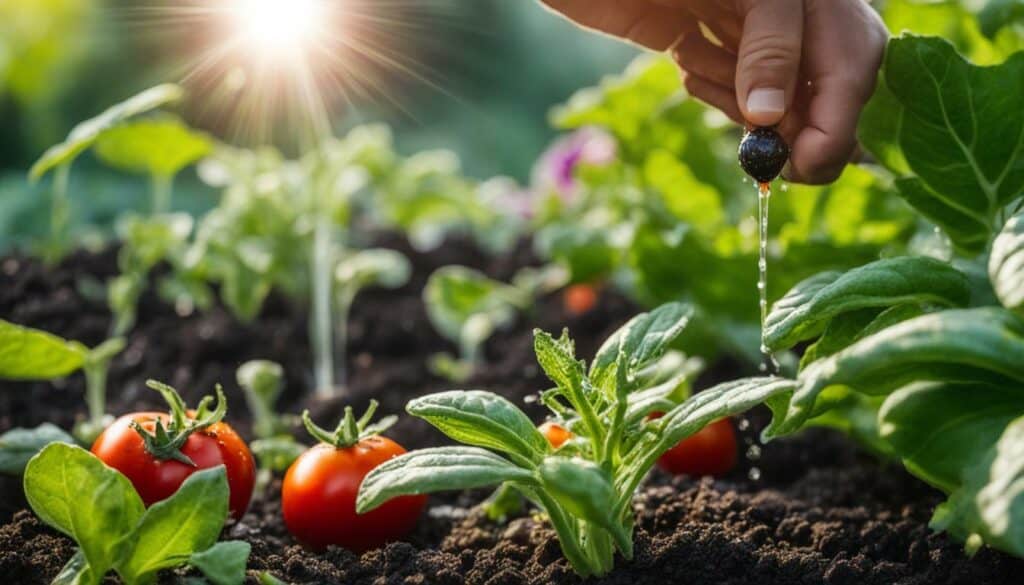
When it comes to pest and disease control, prevention is often the best strategy. Regularly inspecting your plants for signs of damage or disease, such as discolored leaves or holes, can help you identify problems early and take necessary action to address them. Other steps, such as proper soil preparation and using disease-resistant plants, can also help keep your garden healthy and thriving.
By following these tips for watering, feeding, and pest control, you can help ensure the success of your garden and enjoy the beauty and bounty of your plants. With some careful planning and attention, your garden can become a vibrant and productive space that brings joy and satisfaction for years to come.
Pruning and Composting Techniques
Proper pruning techniques and composting can greatly contribute to the overall health and productivity of your garden. Pruning is necessary for removing dead or diseased branches, promoting new growth, and improving flower and fruit production. However, it’s critical to know when and how to prune certain plants to avoid damaging them. For instance, clematis should be pruned right after blooming to promote more flowers and better growth, while holly should be pruned in late winter or early spring to shape it before new growth appears. Roses require regular pruning to remove deadwood and encourage new growth.
Composting is another essential technique for healthy plants. Compost is made from kitchen and garden waste, which is broken down into nutrient-rich soil that can be used to feed plants and improve soil quality. To create compost, gather garden and kitchen waste, such as leaves, grass clippings, fruit and vegetable peels, and coffee grounds, and place them in a compost bin or pile. Turn the compost regularly to aerate it and speed up the decomposition process. When the compost is ready, spread it around your plants as mulch to improve soil quality and help your plants thrive.
Organic compost is the best option for gardeners who want to avoid synthetic fertilizers and pesticides. It’s also a great way to reduce waste and help the environment. By composting your kitchen and garden waste, you’re diverting it from landfills, where it would contribute to greenhouse gas emissions and take up valuable space. Instead, you’re creating a nutrient-rich soil amendment that will benefit your garden for years to come.
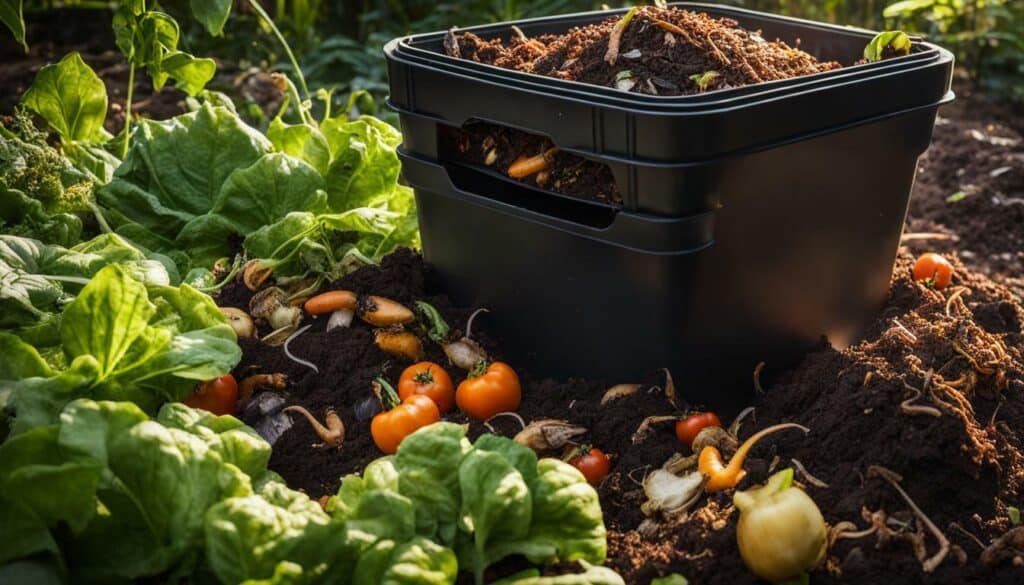
Overall, proper pruning and composting techniques are fundamental for successful and enjoyable gardening. They help to maintain the health and productivity of your garden, while also reducing waste and supporting the environment. By implementing these techniques and choosing the right plants for your growing conditions, you can create a beautiful and thriving garden that will provide you with fresh produce, beautiful flowers, and a relaxing retreat in nature.
Creating a Relaxing and Wildlife-Friendly Garden
In addition to being a beautiful and rewarding space, your garden can also serve as a peaceful retreat and a haven for wildlife. By following the tips and tricks shared in this beginner’s guide, you can create a garden that not only provides a tranquil environment for relaxation but also supports and attracts wildlife, contributing to a balanced and vibrant ecosystem.
Choose plants that support biodiversity: When selecting plants for your garden, consider those that provide food and shelter for wildlife. Native plants are an excellent option as they have co-evolved with local wildlife. Additionally, a variety of plants will attract a diverse range of insects and birds, contributing to a rich and thriving ecosystem.
Create habitats for wildlife: Provide food, water, and shelter for wildlife by incorporating features such as bird feeders, bird baths, insect hotels, and nesting boxes in your garden. These features will attract a variety of wildlife, including birds, bees, butterflies, and other beneficial insects.
Minimize the use of chemicals: Chemical pesticides and herbicides can harm beneficial insects and wildlife, disrupting the balance of your garden ecosystem. Instead, opt for natural pest control methods such as hand-picking pests, using companion planting, and practicing crop rotation.
Provide seating areas: Creating seating areas in your garden will allow you to relax and enjoy your outdoor space while observing the wildlife that visits. Choose comfortable seating and arrange it in a way that offers a view of your garden and its inhabitants.
Incorporate composting: Composting not only reduces waste but also provides a nutrient-rich soil amendment for your garden. Create a compost bin or pile in a quiet corner of your garden and incorporate garden waste, food scraps, and other organic material. The resulting compost will improve soil fertility and contribute to healthy plant growth.
Be mindful of the environment: Take steps to reduce your garden’s impact on the environment. This can include using rain barrels to collect water, choosing organic and sustainable gardening practices, and minimizing waste by composting and recycling.

Creating a relaxing and wildlife-friendly garden requires a bit of planning and effort, but the rewards are well worth it. With the right plants, features, and practices, you can create a garden that provides a peaceful retreat for you and a haven for wildlife.
What Are Some Essential Gardening Tips and Tricks for Beginners?
Looking to start your green journey? Here are some beginner gardening tips and tricks to get you started. First, choose the right plants for your space and climate. Next, prepare the soil properly by removing any weeds or debris. When planting, make sure to water thoroughly and provide adequate sunlight. Regular maintenance like pruning, fertilizing, and pest control is essential.
Conclusion:
Congratulations on completing your guide to the beginners garden! By implementing the tips and tricks shared, you are well on your way to creating a thriving and enjoyable garden. Remember to choose plants that are suitable for your growing conditions, and familiarize yourself with your hardiness zone and frost dates. Proper planting and care techniques, along with watering, feeding, and pest control methods, are essential for healthy plant growth. Don’t forget to utilize compost for a more sustainable garden and consider pruning and creating habitats for wildlife to enhance your gardening experience.
Creating a beautiful and successful garden takes time and effort, but it is a rewarding and enjoyable experience. By following these beginner gardening tips, you can create a garden that provides a relaxing and tranquil environment, as well as supporting a balanced and vibrant ecosystem.
Final Thoughts
In summary, starting a garden can be a challenging but fulfilling journey. With the right knowledge and techniques, you can cultivate a thriving garden that provides enjoyment and benefits for both you and the environment. By wrapping up this article, we hope that you have gained valuable insights and tips for creating your own beginner-friendly garden. We wish you the best of luck on your gardening adventure!
FAQ
Q: How do I choose the right plants for my growing conditions?
A: It’s important to consider factors like climate and sunlight requirements when selecting plants for your garden.
Q: How do I discover my hardiness zone and frost dates?
A: You can determine your hardiness zone by using the USDA hardiness zone map, and knowing your frost dates will prevent damage to your plants.
Q: Should I start small and get to know my garden?
A: Yes, starting small and familiarizing yourself with your garden space is a great way to gain experience and understand its unique characteristics.
Q: How do I plan my garden space effectively?
A: Effective planning involves factors like plant placement, bed organization, and maximizing available space in your garden.
Q: What are some proper planting and care techniques?
A: Proper techniques include following planting guides, providing regular care and maintenance, and ensuring your plants receive the necessary attention for healthy growth.
Q: How can I ensure proper watering, feeding, and pest control?
A: It’s important to water plants appropriately, provide adequate nutrients through feeding, and employ effective pest control methods to maintain a healthy garden.
Q: How do I prune plants correctly and make use of compost?
A: Pruning plants correctly promotes healthy growth, and using compost helps enhance soil fertility and reduce waste.
Q: How can I create a relaxing and wildlife-friendly garden?
A: Creating a space that provides relaxation and supports wildlife involves factors like planting a diverse range of species and creating a welcoming environment for animals.
Q: What should I keep in mind when creating a beginners garden?
A: Remember to enjoy the process, be mindful of watering and feeding, watch out for pests, and create a space where you can relax and appreciate your hard work.
Source Links
- https://miraclegro.com/en-us/gardening-101/10-top-gardening-tips-for-beginners.html
- https://www.foodnetwork.com/grilling/grilling-central-how-tos/beginner-gardening-mistakes-to-avoid
- https://www.gardenersworld.com/how-to/grow-plants/gardening-for-beginners-10-tips/
- https://www.almanac.com/vegetable-gardening-for-beginners
- https://growinginthegarden.com/gardening-for-beginners-how-to-start-a-garden-in-8-simple-steps/
- https://shiplapandshells.com/beginners-guide-to-flower-gardening/
- https://www.realhomes.com/advice/how-to-choose-plants-for-your-garden
- https://www.homesandgardens.com/gardens/best-plants-for-beginners
- https://www.almanac.com/gardening/frostdates
- https://insearchofyummyness.com/planting-zones-and-frost-dates/
- https://www.feathersinthewoods.com/2017/01/how-to-find-out-your-hardiness-zone-and.html?m=1
- https://commonsensehome.com/start-a-garden/
- https://www.bhg.com/gardening/yard/garden-care/ten-steps-to-beginning-a-garden/
- https://growagoodlife.com/vegetable-garden-map-garden-beds/
- https://learn.eartheasy.com/articles/how-to-plan-a-vegetable-garden-for-beginners/
- https://www.amodernhomestead.com/garden-planning-for-beginners/
- https://gardensavvy.com/gardening-blog/gardening-tips/the-ultimate-guide-to-starting-a-vegetable-garden-for-beginners/
- https://www.simpleshowing.com/blog/6-best-gardening-tips-for-beginners
- https://thistledownsfarm.com/6-simple-pruning-tips-for-beginners/
- https://www.gardeners.com/how-to/all-about-composting/5061.html
- https://www.gardendesign.com/how-to/
- https://www.nhm.ac.uk/discover/seven-ways-to-create-a-wildlife-friendly-garden.html
- https://www.wildlifetrusts.org/actions/how-start-wildlife-garden-scratch
- https://www.homesandgardens.com/ideas/wildlife-garden-ideas
- https://journeywithjill.net/blog/
- https://journeywithjill.net/start-here/
- https://journeywithjill.net/about-journey-with-jill/





Leave a Reply